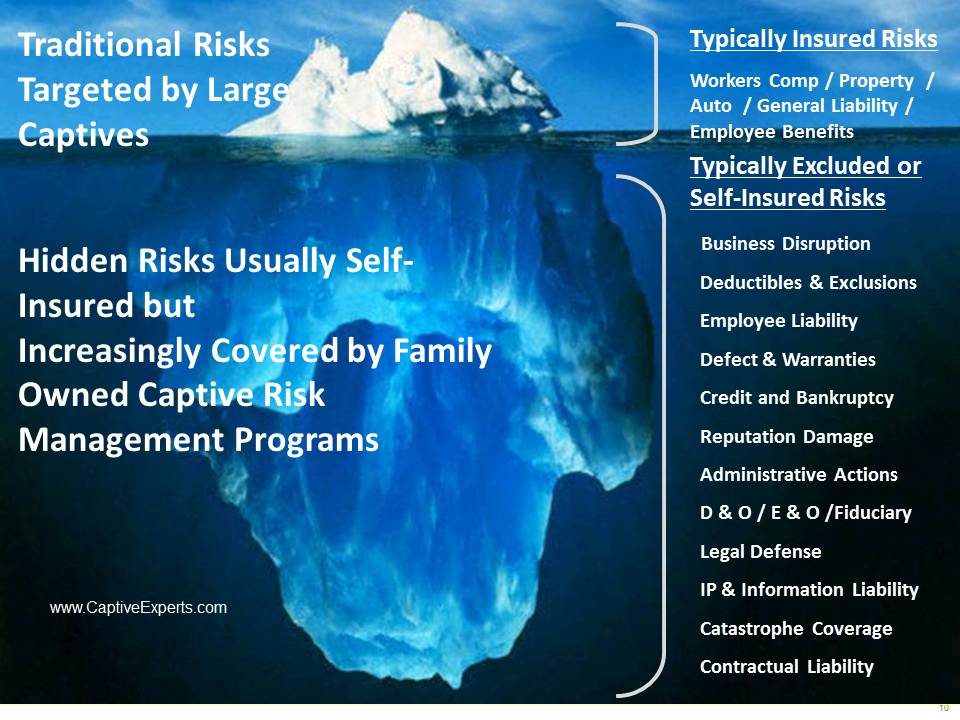A insurance and risk assessment is the first step in insurance program design and underwriting, and should be the initial focus of captive design and feasibility study work.
Listed below are many of the types of risk a captive can address that our analysts evaluate exposure to in the captive design phase of client engagements. We begin a risk assessment by requesting completion of this confidential client underwriting questionnaire.
What to expect if we conduct a risk assessment for you:
- that you likely are self insuring significantly more risk exposure than you realized – our experience suggests nearly every business neglects risk analysis and control to some degree or another. You may have been lucky for decades with good loss experience and minimal unexpected litigation. Our risk assessment highlights your exposure to material unexpected claims, litigation, administrative enforcement actions and other events that could cause serious losses and other business disruption expenses if you continue to neglect the risk assessment, control and mitigation activities captives are designed to formally address. Many businesses failures, even subsequent personal bankruptcies, are direct consequences of risk management neglect.
- you will discover your commercial insurance portfolio has extraordinary similarities to Swiss cheese, with greater holes and gaps and limitations in coverage than you were aware of.
Designing a captive involves determining the types of insurance it will offer, the fronting, reinsurance and other insurance business transaction elements it will enter into.
See the list below of many types of customized insurance coverage captives can offer. These lists of course are not all inclusive. When we are retained to design and form your captive, we consider all possible types of policies and can customize them as necessary to meet your specific goals and objectives.
Common Commercial P&C Insurance Lines Large Captives Traditionally Targeted and Integrate in Designs to Reduce Overall Cost of Commercial Insurance Programs:
- General Liability
- Professional Liability
- Products Liability
- Umbrella Liability
- Property
- Inland Marine
- Commercial Vehicle – Truck and Auto Property and Liability
- Workers Comp
- Health and other Employee Benefit Coverages (newly targeted area of great interest)
Less Common Casualty and Property Lines of Coverage Captives Offer (often expensive in commercial markets if available at all):
- Advertising and Marketing Liability
- Administrative Government Action Liability
- Anti-Trust and Unfair Practices Insurance
- Audit Liability
- Bankruptcy Risks
- Business Credit Loss Insurance (loss of creditworthiness)
- Business Document Forgery and Counterfeiting Insurance
- Business Extortion Insurance
- Business Interruption Insurance
- Business Reputation Insurance
- Business Disruption and Interference Liability
- Competition (unfair competition) Liability
- Contractual Liability
- Construction Defect Insurance
- Credit and Collection Risks
- Cyber and Data Security Liability
- Intellectual Property Infringement
- Intentional Acts
- Deceptive Trade Practices
- Deductions and Retentions on Commercial Policies
- Directors and Officers Liability Insurance
- Employment Practices Liability Insurance
- Employee Benefit Liability
- Environmental Liability Insurance
- Errors and Omissions Insurance
- Legal Liability Defense
- Libel and Slander Insurance
- Malpractice for Licensed Professionals
- Patent Infringement
- Performance Liability Insurance
- Political Risks
- Product Liability Insurance
- Professional License Defense
- Regulatory Risks
- Reputation Risks
- Structural Defects Liability Insurance
- Subcontractor Default
- Supply Chain Disruption
- Title Insurance
- Trade Credit Risks
- Trademark Infringement Insurance
- Whistleblower Liability
Even More Specific Types of Insurance Captive Designs Can Consider:
- Cargo Loss Insurance
- Cash In Transit Insurance
- Commercial Crime Insurance
- Communications Breakdown or Interruption Insurance
- Computer Loss of Data Insurance
- Computer “Hacker” Insurance that results in loss to the business
- Computer Software Liability Insurance
- Computer Virus Insurance which resulted in loss of business data due to infection
- Confiscation and Expropriation Insurance
- Contract Frustration Insurance
- Copyright Infringement
- Counterfeiting of Product “Loss of Profit” Insurance
- Crop Insurance
- Currency Risk Insurance
- Delay in Start Up Insurance
- Earthquake and Earth Movement
- Eminent Domain Insurance
- Employee HIV Contamination Insurance
- Financial Crime and Embezzlement Insurance
- Force Majeure Insurance
- Foreign Operations Insurance
- Goods In Transit Insurance
- HIPAA Compliance
- Identified Market Risk Insurance
- Insurance Failure and Bad Faith Insurance
- Judicial and Administrative Delay Insurance
- Lawsuit Interruption Insurance
- Labor Cost Insurance
- Legal Expenses Insurance
- Lender Failure Insurance
- Loss of Key Customer Insurance
- Loss of Key Employee Insurance
- Loss of Key Supplier
- Loss of Goodwill Insurance
- Machinery Breakdown Insurance
- Mold and Micro Organisms
- Patent or Trademark Infringement Insurance
- Political Risk Insurance
- Producing Trees and Plant Replacement Insurance
- Product Flooding Insurance
- Product Launch Insurance
- Product Tampering Insurance
- Production Benchmark Insurance
- Product Recall
- Property Damage Insurance
- Rework Liability
- Securities Violation
- Strike and/or Labor Unrest Insurance
- Stop Loss (Employee Benefits – limited to US domiciled captives for US EB risks)
- Trade Secret Insurance
- Terrorism Insurance
- Theft of Company Property or Funds Insurance
- Trade Credit Loss Insurance
- Patent or Trademark Infringement by another Insurance
- Warranty (extended)
- Weather Risk Insurance (Wind/Hail/Flood/Hurricane)
Excess / Surplus Coverage
- Excess or Surplus Insurance (above limits of other coverage)
- Excess or Surplus To Limit Risk Pool Exposure
Bonds
- Buyer Credit Risk bond
- Customs Duty Bonds
- ERISA Guarantee Bonds (Limited to US Domiciles)
- Fidelity and Surety Bonds
- Performance Bonds
Third Party Coverage Increasingly Approved for Direct Captive Issuance
- Product Extended Warranty
- Tenant Insurance
- Event Insurance
- Forced Place Insurance
- Loan Default / GAP Coverages
These are some of the many risks well suited for a captive insurance company program design. A captive has the advantage of your insured operating businesses paying premium to a CIC entity you own, not to an unrelated insurance company. If losses are controlled, your CIC can building up investment asset to protect against loss on a tax advantaged basis potentially with wealth protection and transfer benefits incorporated as well. Your CIC can also access the wholesale reinsurance marketplace where cost of coverage is often much lower than direct commercial insurance.
Learn more about the underwriting and actuarial work scope required to design and form your captive, and the associated costs, by clicking here.

